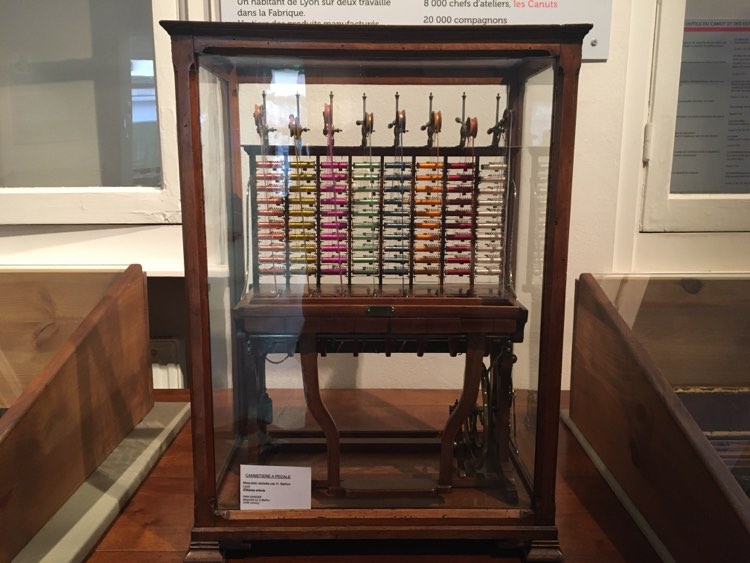Lyon is a city with a thousand facets. Sometimes "Capital of the Gauls", sometimes "Gastronomic Capital of France" or "Capital of the Resistance." But did you know that Lyon was the capital of French silk, was there a time? After Paris and Bordeaux, this time, Just Focus takes you to Lyon in the footsteps of its canuts.
Francois I: Monarch bursar
How did Lyon become a city historically known for its silk? To find out, we must go back the red thread of history to the Renaissance period. In 1536, to be more precise. It was under Francois 1st that Lyon became a major player in the silk industry. During the Middle Ages, when trade routes could be used, tons of silks crossed Lyon. Especially those coming from Italy. Popular fairs occupied the Rhône-Saône axes (the two emblematic rivers of Lyon), to sell these precious fabrics. Lyon, by its location, was a home port very frequented by merchants. It was partly thanks to this that in 1540 the king granted the city a monopoly on the import of silk.  In order to prevent French money from going to Italy, he invited fabric merchants and weavers to settle in Lyon. Two of them are credited with launching the Lyonnaise machine. Étienne Turquet and Barthélemy Naris, Lyonnais by adoption, established the first fabric factories.
In order to prevent French money from going to Italy, he invited fabric merchants and weavers to settle in Lyon. Two of them are credited with launching the Lyonnaise machine. Étienne Turquet and Barthélemy Naris, Lyonnais by adoption, established the first fabric factories.
"For thepurpose of erecting in this city the mestiers to make cloth of gold, silver and silk. "- Turquet, session of the Consulate of August 28, 1536
With the support of the king, they helped in the development of the Lyon silk industry. In exchange, they are exempt from any tax or 'military' service provided they work only in the city of Lyon and never again elsewhere. Suffice to say that the offer was extremely popular. During the 16th century, Lyon saw its population grow from 30,000 to 100,000 inhabitants.
The birth of "La Grande Fabrique" de Soie
The "Grande Fabrique" Lyonnaise was set up during the 17th century. This nickname refers to the entire Lyon silk industry. At this time, workers in the silk industry can be separated into 2 groups: The Canuts and the Silky. The Silks are the merchant-traders. They provide orders as well as drawings and raw materials to the Canuts. While the Canuts are the master weavers, expert handlers of the looms. During the 17th and 18th centuries, Lyon and La France were known around the world for being pioneers of fashion. It is Philippe de Lasalle, nicknamed "the first designer of Lyon", who will use Lyon silk to create a new fashion and new silks. Its motifs include flowers from nature, knotted ribbons, beautiful birds or landscape natures. All its motifs have the particularity of being bright and nuanced colors and used for very large format designs. Its popularity is such that its fabrics will adorn and decorate the Palace of Versailles. During these two centuries, Lyon's industry prospered. 40% of the city of Lyon works on 15,000 looms. King Louis IV and Colbert gave more power to this national industry by multiplying orders for the Court and Versailles. Its popularity is such that even today, we can find fabrics and works of Lyon in the European Courts. Philippe de Lasalle even created fabrics for Empress Catherine II of Russia.
"Each royal family had its own color and patterns. The French royal family wore blue, Saxony was red. We wove a lot for Empress Catherine of Russia who loved partridge motifs." says Virginie Varenne, director of the Maison des Canuts in Lyon.
The revolution of the Jacquard looms:
Despite the difficult impact of the Revolution and the Terror on the silk industry, the Grande Fabrique managed to survive. Emperor Napoleon Bonaparte breathed new life into it, with his commissions to decorate his palaces and dress his court. It was during this period that looms began to be mechanized, especially with the invention of the "Jacquard" loom. The mechanics of this new loom "automate" much of the weaver's work. 
Virginie Varenne explains. "Before on pickpockets, it took 2-3 men to operate the machine. The mechanics of the Jacquard looms allowed the work to be less arduous and more efficient."
Due to the size of the industrial profession, the famous district of the "Croix Rousse" is built and will bring together 3/4 of the Canuts Lyonnais. The main feature of the buildings in this district is its workshops-housing with high ceilings and large windows.
Lyon in 1831 and 1834: Les révoltes des Canuts
In the 19th century, Lyon had around 48,000 weavers. 8,000 of them are workshop managers (owners of their looms) and 40,000 are journeymen. Many Canuts live in poverty. They work in harsh conditions, more than 18 hours a day, for a pittance. The Silks, on the pretext of foreign competition or market constraints, refuse them the minimum tariff. They buy them the cheap silk rolls and sell them at a good profit. The Canuts, tired of their conditions, went on strike on November 19, 1831. They immediately find themselves facing the National Guard who shoot at them. On November 22, 1831, the Canuts took to the streets, armed with their black flag and shouting: Live by Working or Die as Fighting They managed to occupy part of the city, thanks to members of the National Guard who joined the fight. On December 5, Louis-Philippe sent 20,000 troops and 150 cannons to suppress the canuts. Taking advantage of the success of his operation, Louis-Philippe banned the minimum tariff and dissolved the National Guard. Despite the failure of this revolt, it is considered one of the first workers' struggles of France. The Canuts rose up a second time in 1834 to protest against the drop in their wages. This revolt will be crushed in a brutal way by the police. So much so, that the incidents will be called, "Bloody Week".
They managed to occupy part of the city, thanks to members of the National Guard who joined the fight. On December 5, Louis-Philippe sent 20,000 troops and 150 cannons to suppress the canuts. Taking advantage of the success of his operation, Louis-Philippe banned the minimum tariff and dissolved the National Guard. Despite the failure of this revolt, it is considered one of the first workers' struggles of France. The Canuts rose up a second time in 1834 to protest against the drop in their wages. This revolt will be crushed in a brutal way by the police. So much so, that the incidents will be called, "Bloody Week".
Lyon Silk in popular culture:
Today, a few handlooms exist to meet the demands of museums and private orders. However, the industry has not died out. Although Lyon had to diversify into the production of different types of fabrics, there are still silk workers in the city, but orders are far from the golden age of the Soierie Lyonnaise. Despite this, the image of Lyon and its reputation as silk have helped maintain the myth of the canuts. Its history has made it possible to develop in local popular culture, an interest in preserving heritage through books. Here is a small list to delight readers and history lovers (of all ages).
- Canute who is you? by Virginie and Philippe Varenne
- Claudine de Lyon by Marie-Christine Helgerson
- Le Chant des Canuts by Louis Muron
- Dans la révolte des canuts: Journal de Pauline, 1831-1832 de Catherine de Lassa
- Les Revoltes des Canuts by Fernand Rude
In 1894, Aristide Bruant composed "Le Chant des Canuts". It is a song inspired by the French translation of Heinrich Heine's "Weavers of Silesia". Having become very popular, this song has been covered several times by French singers. Despite their disappearance, the Canuts and the Grande Fabrique remain jewels of Lyon's heritage. For your next visit to Lyon, consider watching La Croix Rousse. Can you imagine the sound of the trades?







































